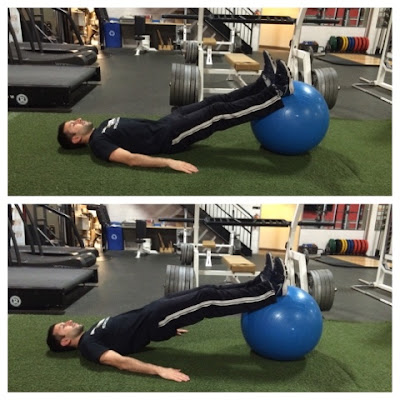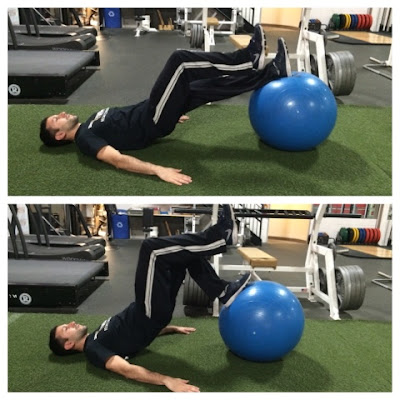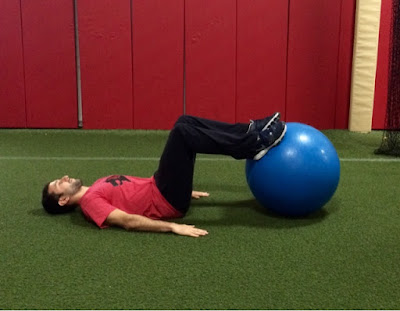Hamstring injuries are excessively common. Almost everywhere it's heard from people, and also athletes, that they "tore" their hamstring. The worst part about it is that they're injuring themselves while doing simple daily activities or basic exercises. Even if the injury is as small as a muscle cramp or as large as a strain, the glute-ham area is usually neglected regardless in terms of training. Again, hamstring and glute strength being improved must be a necessity. Today's post is about the Stability Ball Leg Curl. Also known as the Stability Ball Hamstring Curl, this exercise builds upon the base movement built by the Stability Ball Glute Bridge, albeit with more hamstring activation.
Like I mentioned in my last post, the hamstrings have two functions: 1) extend the hips and 2) flex the knees. They are used daily along with the glutes and other muscles to help with walking, running, or jumping. Maintaining strength and flexibility in this area is crucial for sports performance as well as injury prevention. The Stability Ball Leg Curl can be used to assist with this.
This variation of the curl is an advanced movement that even the elite could have trouble with. I recommend mastering the Glute Bridge/Stability Ball Glute Bridge, as well as being able to do Eccentric, Isometric, and Single Leg Repetitions of the glute bridge with or without the ball.
Once positioned correctly, attempt to roll the ball in by contracting the glutes and hamstrings, and curling the legs in, aiming the heels of the feet towards the glutes. Keep the abs and body activated and raised above the ground at all times.
The exercise should be worked until 3-4 sets of 8-12 repetitions are possible. For advanced versions, attempt to do the glute bridge progressions such as eccentric repetitions (slow lengthening for seconds at a time), isometric repetitions (static holds for time at the top of the movement), or single leg curls for unilateral stability and strength (which I'll be discussing in future posts).
Alex Adragna, CSCS
The Stability Ball Leg Curl is unlike a machine hamstring curl in that it not only activates the hamstrings and glutes, but also requires the torso, or "core" muscles, and stabilizer muscles in the area to be recruited to assist in the movement.
Stability Ball Leg Curl
To begin, lay down with the arms out on the ground, legs extended, and heels of the feet on the stability ball. Contract the abdominal and torso muscles, extend the hips, raise the body off the ground, and stabilize in this position before commencing the curl. This is the new starting position.
Once positioned correctly, attempt to roll the ball in by contracting the glutes and hamstrings, and curling the legs in, aiming the heels of the feet towards the glutes. Keep the abs and body activated and raised above the ground at all times.
The exercise should be worked until 3-4 sets of 8-12 repetitions are possible. For advanced versions, attempt to do the glute bridge progressions such as eccentric repetitions (slow lengthening for seconds at a time), isometric repetitions (static holds for time at the top of the movement), or single leg curls for unilateral stability and strength (which I'll be discussing in future posts).
BONUS!
With my previous post I didn't include any images of any advanced movements, so I've decided to cover the Single Leg Stability Ball Leg Curl with this post! The single leg curls are difficult even for advanced athletes, so do not get discouraged if unable to do them. Again, this builds up unilateral (single-side of the body) strength and stability in the leg, as compared to the Stabilty Ball Leg Curl, which works bilaterally.
With my previous post I didn't include any images of any advanced movements, so I've decided to cover the Single Leg Stability Ball Leg Curl with this post! The single leg curls are difficult even for advanced athletes, so do not get discouraged if unable to do them. Again, this builds up unilateral (single-side of the body) strength and stability in the leg, as compared to the Stabilty Ball Leg Curl, which works bilaterally.
Single Leg Stability Ball Curl
To begin, lay down with the arms out on the ground, one leg slightly bent and elevated while the other leg is extended onto the ball. The heel of the extended leg should be placed on the stability ball. Once again, contract the abs and torso muscles, extend the hips, lift the body off the ground, and stabilize in this position before beginning the curl. The only difference is that more stability is required for this movement, as well as being able to keep the non-working leg elevated throughout the movement. This is the starting position.
After being positioned correctly, attempt to roll the ball in by contracting the muscles of the extended leg, and curling the leg in, aiming the heel of the working leg's foot inwards. Keep the abdominals and rest of the body activated and raised above the ground at all times.
Proficiency in the movement is only going to be achieved by practice and training. Test this technique and some of the progressions and let me know how it goes. Good luck!
Alex Adragna, CSCS










